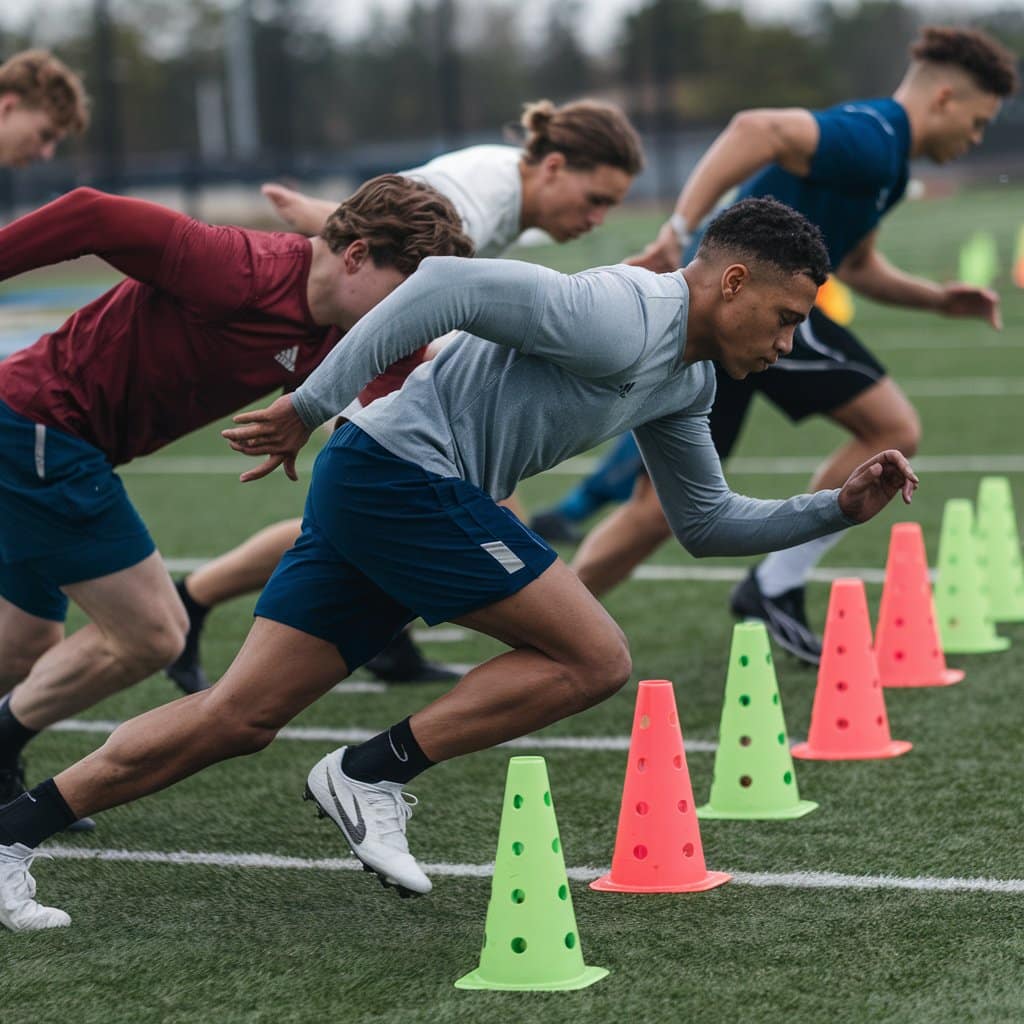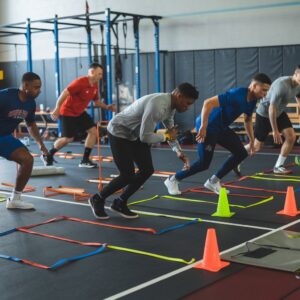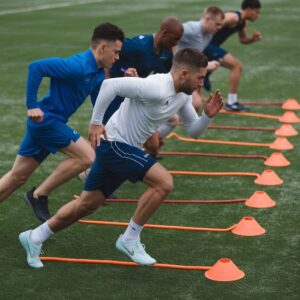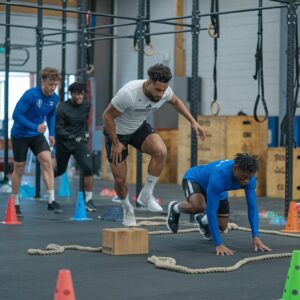Agility is a crucial component of athletic performance, impacting speed, coordination, and overall effectiveness in various sports. Sports agility drills are designed to enhance these qualities, making them essential for athletes looking to improve their game. This comprehensive guide will explore the importance of agility training, provide a variety of effective drills, and offer tips for integrating agility workouts into your training regimen.
Understanding Agility in Sports
Agility refers to the ability to move quickly and easily while maintaining control of your body. It combines speed, balance, and coordination, which are vital for athletes participating in sports such as football, basketball, soccer, and tennis. Improved agility can lead to better performance on the field or court, allowing athletes to react faster to opponents and execute plays with precision.
The Importance of Agility Training
Agility training is not only about improving performance; it also plays a significant role in injury prevention. Many sports involve quick changes in direction, which can put stress on the joints and muscles. By strengthening the muscles that stabilize the joints and improving overall body control, athletes can reduce their risk of injuries. Furthermore, agility training enhances an athlete’s ability to perform skills that require quick footwork, such as dodging, cutting, and sprinting.
Benefits of Agility Drills
- Improved Speed: Agility drills enhance your quickness, enabling you to accelerate faster and change directions with ease.
- Enhanced Coordination: These drills develop your hand-eye and foot-eye coordination, critical for success in most sports.
- Injury Prevention: Strengthening stabilizing muscles through agility training can reduce the risk of injuries.
- Increased Balance: Agility workouts promote better balance, which is essential for maintaining control during dynamic movements.
- Better Reaction Time: Agility drills train your nervous system to react more quickly to stimuli, improving your overall responsiveness in gameplay.
Top Sports Agility Drills
1. Ladder Drills
Ladder drills are among the most effective agility exercises, focusing on foot speed, coordination, and agility. You can use a flat agility ladder laid on the ground. Here are a few variations:
- Two Feet In Each Square: Run through the ladder, placing both feet in each square before moving to the next. This drill builds foot speed and rhythm.
- In-and-Outs: Place one foot inside the square and the other outside, alternating as you move through the ladder. This variation enhances coordination and lateral movement.
- Side Shuffles: Face sideways and shuffle through the ladder, placing both feet in each square. This drill targets lateral agility.
- Single Leg Hops: Hop through the ladder on one leg. This drill focuses on balance and strength while enhancing agility.
2. Cone Drills
Using cones allows for various movements that mimic game situations. Set up cones in different patterns to improve your agility:
- 5-10-5 Shuttle: Set up three cones in a straight line, five yards apart. Start at the middle cone, sprint to one side cone, touch it, then sprint to the other side cone, and return to the middle. This drill emphasizes quick changes in direction.
- T-Drill: Arrange cones in a T shape. Start at the base of the T, sprint to the top, shuffle sideways to one side cone, return to the top, and shuffle to the other side cone before returning to the start. This drill targets multi-directional agility.
- Box Drill: Set up four cones in a square. Start at one cone, sprint to the next, shuffle to the third, backpedal to the fourth, and repeat. This drill enhances footwork and body control.
3. Plyometric Drills
Plyometric exercises improve explosive power and speed, essential components of agility. Here are a couple of plyometric drills:
- Box Jumps: Jump onto a sturdy box or platform, focusing on soft landings. This drill builds explosive leg strength and power.
- Lateral Jumps: Jump side to side over a line or low hurdle, emphasizing quick foot movements. This drill enhances lateral movement and agility.
- Depth Jumps: Step off a box and immediately jump upon landing. This drill improves reactive strength and explosiveness.
4. Sprints and Acceleration Drills
Sprinting is fundamental to agility. Incorporate acceleration drills to improve your speed and quickness:
- Wind Sprints: Sprint for a set distance (e.g., 30-50 meters) at maximum effort, followed by a recovery period. This drill develops speed endurance.
- Hill Sprints: Sprint up a hill to build strength and power in your legs, which will translate to improved agility on flat surfaces. This drill enhances explosive power.
- Flying Sprints: Start with a slow jog for about 20 meters, then accelerate to full speed for 30 meters. This drill helps improve top-end speed.
5. Reaction Drills
Improving your reaction time is crucial for agility. Use a partner or a coach to create unpredictable scenarios:
- Ball Drop: Have a partner drop a ball at random heights, and react quickly to catch it. This drill enhances hand-eye coordination and reaction speed.
- Direction Change: Your partner shouts directions (left, right, forward, backward), and you must quickly change your direction to follow their commands. This drill improves your agility and responsiveness.
- Mirror Drill: Face a partner who will move in various directions, and you must mirror their movements as quickly as possible. This drill enhances agility and reaction time.
Integrating Agility Drills into Your Training Routine
Incorporating agility drills into your training routine is vital for optimizing performance. Here are some tips:
- Frequency: Aim to include agility drills in your training at least 2-3 times a week. This frequency allows for consistent improvement.
- Warm-Up: Always warm up before agility workouts to prevent injury. A dynamic warm-up focusing on mobility and activation is recommended.
- Progressive Overload: Gradually increase the intensity and complexity of drills as your agility improves. Start with basic movements and progress to more challenging ones.
- Variety: Mix different drills to target various aspects of agility and keep your training engaging. This variety will prevent boredom and overuse injuries.
Common Mistakes to Avoid
When performing agility drills, avoid the following pitfalls to maximize effectiveness:
- Improper Form: Focus on maintaining proper form to prevent injuries and maximize benefits. Poor form can lead to ineffective training and increased injury risk.
- Lack of Focus: Stay mentally engaged during drills to improve your reaction times and coordination. Distracted training can hinder progress.
- Skipping Warm-Up: Never skip your warm-up, as it prepares your body for intense movements. A proper warm-up increases blood flow and reduces injury risk.
- Neglecting Recovery: Allow for adequate recovery between agility sessions to prevent fatigue and overtraining. Incorporating rest days is crucial for long-term improvement.
Measuring Progress in Agility Training
Tracking your progress in agility training is essential to ensure you are improving. Here are some methods to measure your agility:
- Timing Drills: Use a stopwatch to time your performance on various drills, such as shuttle runs and ladder drills. Regularly compare your times to assess improvements.
- Video Analysis: Record your agility drills and analyze your movements. Look for areas where you can improve your technique and efficiency.
- Performance in Games: Monitor your performance in competitive situations. Increased speed, better reaction times, and improved overall gameplay can indicate agility improvements.
Conclusion
Sports agility drills are essential for athletes seeking to enhance their performance. By incorporating various drills into your training regimen, you can improve your speed, coordination, and overall athleticism. Remember to prioritize consistency, proper form, and a well-rounded approach to agility training. With dedication and the right drills, you’ll be well on your way to achieving your athletic goals.
FAQ Section
What are agility drills?
Agility drills are exercises designed to improve an athlete’s ability to move quickly and change direction effectively. They enhance speed, coordination, and balance.
How often should I do agility drills?
Aim to perform agility drills 2-3 times a week for optimal results. Incorporate them into your regular training routine for the best performance improvement.
Do I need special equipment for agility drills?
While you can use equipment like agility ladders, cones, and hurdles, many agility drills can be performed with minimal equipment or even just bodyweight.
Can agility drills help prevent injuries?
Yes, agility drills can help prevent injuries by strengthening stabilizing muscles, improving balance, and enhancing overall body control.
What sports benefit most from agility training?
Sports such as football, basketball, soccer, tennis, and martial arts benefit significantly from agility training due to their demands for quick movements and changes in direction.
How can I measure my agility improvement?
You can measure agility improvement through timed drills, comparing your performance on shuttle runs or cone drills over time to track your progress.




